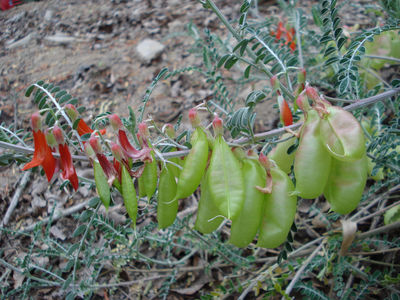Geography and distribution
Balloon pea occurs naturally throughout the dry parts of Southern Africa, in the Western Cape and up the west coast as far north as Namibia and into southwest Botswana, and in the western Karoo to Eastern Cape, Northern Cape, Free State, KwaZulu-Natal and Lesotho. Occurrences further north and east in South Africa may be introduced.
Description
Sutherlandia frutescens is a lax spreading shrub to 1.2 m high, with prostrate to erect stems. The leaves are 3-10 cm long, and are pinnate with oblong to linear-elliptic leaflets, which are mostly three or more times longer than wide, and slightly to densely hairy. The leaves are greyish-green to silvery in appearance. The bright orange-red to scarlet flowers are borne in terminal racemes, each of 3-6 flowers. Flowering occurs from July to December. The fruit is a balloon-like, inflated membranous pod, 1.3-2 times as long as wide, bearing a persistent upturned style. The seeds are black, flattened, and about 3 mm in diameter.
There are a number of closely related species, for example S. microphylla and S. montana , but they are difficult to distinguish from S. frutescens because they often grade into each other. Some botanists consider them to be merely different forms of a single large and variable species. Currently six species are recognised in the genus, all from Southern Africa.
Uses
Sutherlandia frutescens has a long history of medicinal use in southern Africa. Traditionally it has been used for treating a range of conditions, from wounds and fever, to digestive problems and internal cancers. It is used today as a herbal remedy for treating a wide range of ailments, such as eye problems, colds, asthma, arthritis, rheumatism and haemorrhoids. It is also used for treating anxiety and depression, and for improving appetite.
Preliminary research indicates that Sutherlandia frutescens is a stimulant of the immune system, as well as having some anti-bacterial, anti-inflammatory and anti-diabetic activity. Further research and clinical trials are underway to determine its efficacy, including its use in treating patients with cancer and HIV/AIDS. However, as yet there is no conclusive scientific evidence to support the numerous claims and it appears to be anecdotal that this traditional medicine can cure cancer. Indeed, claims that the plant is a 'miracle cure' are highly misleading and exaggerated.
Despite the bitter taste of its leaves, Sutherlandia frutescens is relished by cattle and sheep, to the extent that it may be completely grazed out in some areas. Sunbirds pollinate the attractive, butterfly-like red flowers. The lightweight, papery, inflated pods enable the seed to be dispersed easily by the wind.
Sutherlandia frutescens is an attractive ornamental which in warm temperate regions can be grown as a perennial in a warm, dry shrub border. It is tolerant of temperatures as low as -5˚C as long as soil drainage is good. In cool climates it is a suitable subject for the cool glasshouse or conservatory, and can also be grown as an annual or biennial in summer bedding displays.
Millennium Seed Bank: Seed storage
Kew's Millennium Seed Bank Partnership aims to save plant life world wide, focusing on plants under threat and those of most use in the future. Seeds are dried, packaged and stored at a sub-zero temperature in our seed bank vault.
Description of seeds: Average 1,000 seed weight = 8.7 g
Number of seed collections stored in the Millennium Seed Bank: 9
Seed storage behaviour: Orthodox (the seeds of this plant survive being dried without significantly reducing their viability, and are therefore amenable to long-term frozen storage such as at the MSB)
Germination testing: 100% germination [pre-sowing treatments = seed scarified (chipped with scalpel); germination medium = 1% agar; germination conditions = 21°C, 12/12].
Composition values: Average oil content = 2.8%. Average protein content = 29.2%.
Balloon pea at Kew
Balloon pea pods and stems are held in the behind-the-scenes Economic Botany Collection.






